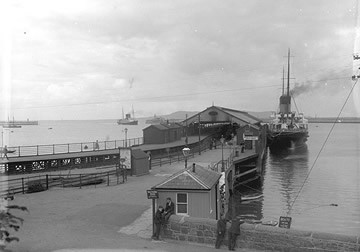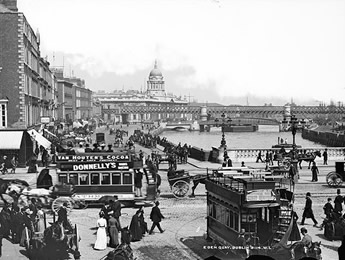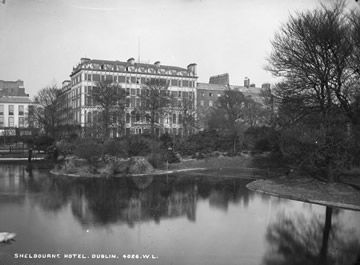Emigration and migration
View the photo galleryIn 1911 there were more than 80 cross-channel sailings per week to Britain from Dublin port. Many of the sailings carried emigrants leaving a country and a city unable to offer a basic living. Some were Dubliners, but many were from the Irish countryside and were merely passing through the city, since there was no work available to them. The emigration of Dubliners traditionally continued at a pace far behind that of the rest of the country. In the decade 1891 to 1901 430,393 people emigrated from Ireland; only 9,487 of these were from Dublin. Dublin, alone amongst Irish counties, enjoyed a small increase in total population in the second half of the nineteenth century.
There is clear evidence that the number of people from rural areas living in Dublin was remarkably low, particularly in comparison to the inward migration experienced by other comparable cities in the United Kingdom. Less than 10% of all migration undertaken by Irish people ended in Dublin (see return for the Ryan household of Clarendon St.). In many respects this was related to the stagnation of the city’s economy. Dublin was unable to absorb the tens of thousands who left the land every decade.
Those who did come from the country generally came from the surrounding counties of Meath, Kildare and Wicklow, or other eastern counties like Wexford, with only 7% of migrants living in Dublin in 1911 from Connacht. Shopkeepers and publicans, a high proportion of whom were from the country, often chose to employ people who came from the same area as themselves (see return for McGreevy's pub at Eden Quay). For example, the majority of the people who worked in the shops and pubs of Talbot Street in 1911 were born in the same county as the owners.
Those who did not live in the shops (Meagher's of North Earl St.) and pubs (Heaslip's of Eden Quay), or in boarding houses, often lived with relatives (Ryan return, Clarendon St.), neighbours or work colleagues (see Woods return, Canning Place) who had come to Dublin before them. The extent to which Dublin was primarily a city for native Dubliners is also emphasised by the number of boarding houses which were filled with Dubliners, including a 19-room boarding house on Church Street where 108 of the 114 lodgers were born in Dublin.
The hotels of the city, like Bessler's of Salthill, offer a valuable insight into the people who lived and worked in Dublin, as well as those who travelled there. The Shelbourne Hotel on Stephen’s Green was among the most prestigious in the city, a place where many moneyed visitors stayed. The staff was truly cosmopolitan. Although many who worked as cooks and chambermaids were Irish, the waiting staff was comprised of eight Germans, three Austrians, and one each from Bohemia and England. They all lived together in a house near the hotel on Kildare St. and, on the outbreak of World War I, the German staff were interned.
Many of the servants employed in Dublin houses were from country areas. In certain areas country people accounted for three-quarters of the servants employed. Some businesses, including the Guinness brewery (see return for employee Ferry from Manor St.) and the canal companies, employed country people ahead of Dubliners, not least because they were larger and stronger and better used to heavy lifting work. Dubliners, however, were not generally displaced by unskilled rural migrants. For example, city centre tenement streets such as Mabbot Street and Tyrone Street were home to Dublin-born labourers who accounted for almost 90% of inhabitants.
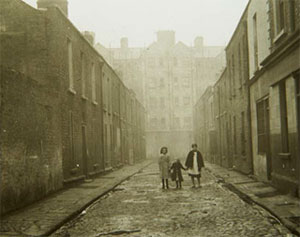
Faithful Place off Lower Tyrone Street, 1913. This area of inner city Dublin was overwhelmingly home to Dublin-born labourers.
(RSAI, Darkest Dublin, No. 45)
The level of country migrants living in the city peaked at times when the rural economy faltered or collapsed. The emergence of widespread famine in the 1840s obviously brought starving victims to the city in search of relief. So did intermittent agricultural depression, including the years from 1879 to 1881 when the city’s workhouses, like the South Dublin Union at James's St. were filled with rural people. The fact that most rural people used Dublin merely as a staging post for emigration is confirmed by the fact that, in 1911, more than 70% of the city’s population had been born there.
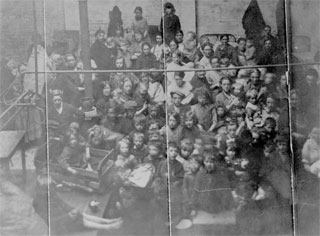
A workhouse scene from 1895. Many of Dublin's workhouses were filled with people from outside the city.
(Irish Personalities List, NPA Box LXII)
Despite the evidence to the contrary, Dubliners were devoted to the notion that the city was being over-run by country people and foreigners, and were particularly devoted to the notion that migrants were displacing Dubliners in employment. And people did come to Dublin to seek work from cities such as Glasgow (Brogan at Bath St.). Some left their wives behind them (Stubley at Barrow St.).
If they faced opposition in the city, that opposition was not confined merely to the streets, but also surfaced in political debate. In March 1907, a speaker at a meeting of Dublin Corporation complained that the Hammond Lane Foundry employed “only Scotsmen and niggers”. In reply the manager pointed out that the workforce was comprised of 87 Irishmen, 15 Scots and one American, and that the employment of the foreigners was the consequence of the lack of specialist skills in the local labour market (see return for Grau of Emmet Square, Blackrock).
Foundries, mills, engineering and electrical firms regularly brought skilled labour to Dublin. Indeed, about 25% of all migrants to Dublin were born outside Ireland. Children returned with their migrant parents, others married Irishmen and women, still more came to work. They came from everywhere, places expected and unexpected, Corfu (Woodroffe of Grotto Place, Blackrock), Jamaica (L’Estrange of Simmonscourt), Hungary (Hoffmann of Charlotte Place), China (Sidford of Haddon Rd., Clontarf), France (Herra of Haddon Rd., Clontarf), Rhodesia (Nunan of Gracepark Avenue) and, of course, America (Byrne of (Haddon Park, Clontarf).
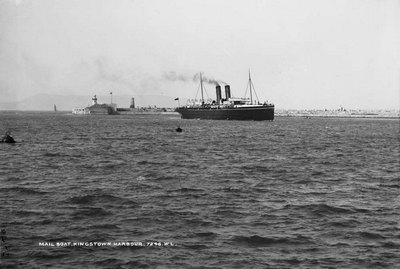
The Mail boat at Kingstown harbour. Kingstown was a point of departure for many emigrants to Britain.
(NLI, LCAB, 7246)
A regular feature of life in the city was the posting of large battalions of the British army (see return for Marlborough barracks, Glasnevin). Dublin was a key city of empire and, as well as skilled labour and military coming to the city, a public service, professional and business class thrived (see return for Irwin of Simmonscourt). Many of these settled in the suburbs rather than in the city centre, and places such as Kingstown and Rathmines had high percentages of non-Dubliners living there. Their children were often taught by teachers, many of them women, who had themselves come from England, like Skinner at Molesworth St., France, like Negre at Grafton St. or even South America, like Bayne at Gracepark Gardens. Schools, too, drew their quota of foreign children to live and study as boarders (see Blackrock College return).

Large battalions of the British army were posted to Dublin. This photograph shows soldiers conducting drills alongside their living quarters at Marlborough Barracks.
(NLI, LROY 11583)
Many of the migrants who came to the city were not Catholics. The most recent wave of migrants, members of the Jewish faith, like the Jacobsens of Camden St., had come from Eastern Europe in the preceding decades and made Dublin their home. They established a thriving community in the south inner city, in the streets around the South Circular Road (see the Ellmanns of Lennox St.). Many were immigrants from Russia (see the Glassers at Martin St.) who were fleeing the pogroms of Tsar Alexander II. They built synagogues and schools and established businesses, and soon became a flourishing aspect of life in Dublin (see return for Solomons family of Elgin Rd., Ballsbridge).

